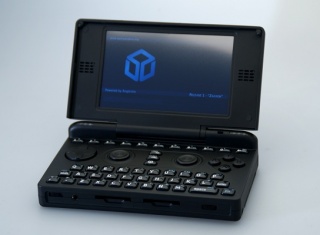Pandora
Contents
Overview
The Pandora is a unique combination of gaming console and pocket computer.
From classic gaming, listening to music, watching movies, viewing pictures, program development or surfing the web to just reading or writing texts, the Pandora has a lot to offer
The Pandora project has been a group effort from the beginning. The hardware development team designed Pandora based on specifications requested by its future users. The main physical features - qwerty keyboard, dual analog nubs, clamshell design, pocketable size - were most prominently voiced by the community. The physical appearance of Pandora is an utilitarian result of getting all the necessary hardware into a pocket sized device. Form follows function, and ergonomic is one of the tall orders made. Before the final design came to be, the testing and funding was also done in a community manner.
There is no other device that has dedicated gaming controls, two analog nubs and a QWERTY keyboard.
It was developed as a gaming device not just to run games made just for it but also to emulate older systems and everyday computing.
The Pandora can do all of this because it is a tiny computer running a custom distribution of Linux based on The Ångström Distribution. Because it runs Linux|GNU, the Pandora isn't just a console but a complete desktop computer with access to tens of thousands of Linux programs.
|
|
Visit the Pandora website for ordering information.
There are three versions, CC, GC and 1GHZ.
Base specs are the same, with the GC having more memory and a newer revision of the PowerVR SGX530 graphics chip. The 1GHZ model has apart from a faster processor with bigger cache, faster main memory, faster graphics memory and faster DSP processor.
Environmenal
Whole unit RoHs,CE,pb free. User replaceable battery. Ease of disassembly. User encouraged replacement of board and screen. Built to last. Quality parts. Long lifespan with updatability on a platform not built for planned obsolesence. Fair wages for manufacture. Minimal packaging, small cardboard box which can be recycled. Ac/Dc adapter optional? Battery recycling program? Research taking place on parts used. Possible release of case design files and board schematics in the future.
Specifications
Hardware documentation has detailed hardware specifications.
- 320g (0.739 lbs)
Core Hardware
- Texas Instruments OMAP3530 SoC or 3570 for 1GHZ model
- 512MB DDR SDRAM.
- 512MB internal storage (NAND)
Display
- Touchscreen TFT-LCD
- 4.3-inch (93.6 x 56.2 mm)
- 800x480 widescreen (5:3)
- Brightness: 300 cd/m2
- Contrast ratio: 450:1
- Viewable in direct sunlight, but it will wash out.
- Response time: tr+tf=30ms
- No ghosting.
- TV-out included in hardware, A/V-OUT Port (similar in appearance to a large USB OTG port) has Composite and S-Video outputs and 3.5mm headphone output and microphone input.
- Separate TV-out signals, picture-in-picture capabilities. [1]
Audio
- Stereo speakers
- Volume control wheel
- Microphone
Input
- QWERTY keyboard
- Gaming controls:
- 8-way D-pad
- Four gaming buttons
- Two shoulder buttons
- Two analogue nubs
- Touchscreen
- Microphone
Connectivity
- 802.11b/g Wi-Fi
- Bluetooth 2.0 + EDR (3Mbps)
- USB
- Standard-A USB host port
- Fully powered (500 mA)
- USB On-The-Go mini-AB port.
- You can use anything that has the appropriate drivers. [2]
- Some devices need to first go through a powered USB hub.
- Standard-A USB host port
Power
- Lithium-ion polymer battery, 4200mAh design capacity.
- 10-20 hours battery life under reasonable load
- 8-12 hours under max CPU load
- 6-8 hours under max CPU load with overclocking
- 5-6 days standby time
- 21 hours playing music with the display off
- Can charge through an AC adapter or USB.
- Charging with the AC adapter takes about 4 hours from near-empty. In 2 hours you get to about 80%.
- Advanced power management capabilities: only need to set a max clock speed; when the CPU is not doing anything it automatically HALTs and does nothing to save power. [4]
- See Power modes.
More Information
512MB Pandoras (early 2012) The Pandoras produced in Germany by Global Components.
Early 2012 systems shipped with an OS that can only address 256MB of the 512MB RAM. You can check this by typing `free` in a terminal. For these systems, an OS update is needed to see and use the full 512MB. As of May 2012, that OS is available as an optional beta update.
It is the spiritual successor to other handheld consoles such as the GP32 and GP2X.
|
Have some expertise, or just some spare time? Get involved! |
|
This wiki is an unofficial community project. Open Pandora Ltd. is not responsible for its content, and it should therefore not be treated as an official source of information about your device. The information contained in this wiki may be incorrect and/or out-of-date. |
